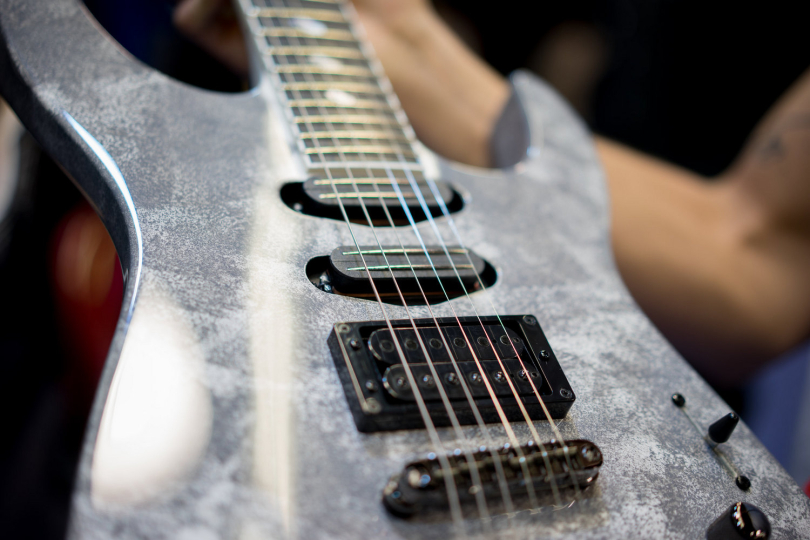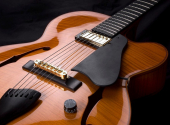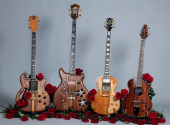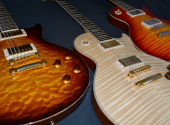
Legendary and Mythical Guitars 4#: Caparison Guitars
In this episode of our series dedicated to famous, but not widely available guitars, we'll take a look at a British-Japanese brand called Caparison. Let this be proof that legendary guitars are not just worn-out vintage pieces used to play protest songs or blues from the sixties, but also modern models with innovative designs, played by the best representatives of the progressive metal scene.
First meeting
The Frankfurt Musikmesse was a phenomenal event and I noticed a lot of people miss it. That includes me and my eldest son, with whom I started going there when he was still a schoolboy, and it lasted until he, as a successful businessman, would invite me to dinner. I alternated between the role of exhibitor and visitor (I enjoyed the latter more), but always considered it the start of the spring season. The event was held around that time, and if the weather cooperated, most of the European and North American manufacturers, traders and visitors had their first outdoor Franziskaner of the year.
In the glory days of this world-famous show, the British amplifier manufacturer Laney always cunningly set up a stand to the right of the entrance to the guitar pavilion. You couldn't miss it and it would have been a shame as there was always a guitar minishow several times a day. For several years, two amazing guitarists took turns playing. Christophe Godin from France, whose hairless, bespectacled look resembled a college math professor, used to bring his Vigier (how else). His visual counterpart, a blond Viking with hair reaching the small of his back named Mattias IA Eklundh (the IA is a nickname) played a type of guitars that I saw for the first time. Their head was shaped like a devil's tail and they had a weird logo that I couldn't read from a distance.
Mattias could produce incredible sounds with that guitar. I was especially fascinated by the way he used the vibrato bar to create long flageolets in positions where most guitars just strum along. Then, when I saw the same guitar a few feet away at the Roland/Boss booth, where Rob Marcello (the guy who replaced Andy Timmons in Danger Danger) used it to demonstrate the new Boss boxes, I decided I needed to investigate this a bit more.
A bit of history
At the turn of the millennium there was nothing to "google", you could at most "yahoo" or "altavist". Even so, I managed to find out that behind the brand name Caparison, as I had written it down, there was a small Japanese workshop that bordered on custom and small-scale production. And that it was run by a master luthier named Itaru Kanno.
What happened was that Jackson (now owned by Fender) had a special subsidiary in Japan. This specialised in developing new models and worked with many famous guitarists. The Soloist Special, the Doug Aldrich Signature and others were developed here. To this day, Jackson MIJ (Made in Japan) models are highly valued and sold for high prices at second-hand stores and auctions.
In the guitar industry at that time, the era of shiny designs was coming to an end and tastes began to turn more towards "fundamentals", i.e. classic shapes and vintage looks. Jackson decided to close his Japanese division. So in 1995, with Itaru Kanno at the helm, the team decided to make its own brand and continue doing things their own way. This is characterised by intensive collaboration with famous guitarists and the implementation of their ideas into the model range.
Why the company was named Caparison, I have not found anywhere. When I asked the current owner about it, he amused me by saying he had no idea. He said it was probably some Asian invention aiming to sound "Western" enough and look good to the eye. Caparison (a word originally from French) refers to the decorative covering of an animal (such as a horse or elephant) that is used on festive occasions. The word is believed to have originated in the Middle Ages when it denoted the decoration of a horse during a joust. How it relates to guitars, I really don't know.
Anyway, Caparison guitars have been in the hands of very famous players – especially from the prog metal scene – since the very beginning and have built up a cult status in record time. Arch Enemy, Soilwork, Obituary, Testament, King Diamond and many other bands, whose members appeared in photos with devil-tail guitars, raised interest in the brand and thus began to rapidly increase the number of interested distributors and dealerships.
The company fitted the guitars with its own pickups, developed its own solid bridge design, and, in addition to the devil's tail, earned a unique trademark with its fingerboard inlays in the form of a cone-shaped clock that tells the time depending on the fret they are on.
New models, new original designs and new elements were added and the manufacturer established itself at the top of modern guitar design, uncompromisingly moving with the times as a counterpoint to all possible vintage designs that were gradually coming into fashion. The Japanese management was always technically inventive and extremely meticulous in terms of quality, but the commercial and marketing side of the business was somewhat lacking. To continue, the brand needed a new owner.
This happened to be a company from Cardiff, UK, owned by George Ösztreicher and his son Gabriel who bought it in 2011. George, whose parents emigrated to the UK from Hungary when he was a young boy, is a seasoned veteran of the guitar industry. He has owned companies making strings, was one of the first to import guitars to Britain from Korea and has been involved with companies such as Tanglewood and Hudson. However, Caparison production remained in Japan and as we can read in their promotional material, Itaru Kanno still personally inspects every guitar that leaves the factory.
What's it all about
In this case, I can start with a personal experience. I've owned a Horus for many years and although I have other guitars, it is my favorite instrument. Why? I have never played any guitar with a more comfortable neck. And I've had a lot of them in my hands. Even the "ultra-fast" necks like the Ibanez Prestige, Jackson, ESP, and other guitars have (i.e. usually a flat U shape) are not as comfortable in terms of action. Bending, tapping and all sorts of left-hand techniques somehow work better on these guitars than on others. At first impression, the neck is certainly not the flattest you've encountered, but it has a strange profile and somehow it "magically" fits my hand (and I'm probably not alone). Even after playing for a long time, one doesn't feel fatigue in the left hand.
But maybe it's just a personal impression. In general, these instruments are renowned for their makers' obsession with precision of details and perfection of overall workmanship, and again from personal experience I must say that I have never received a guitar as well tuned straight from the factory as this one. Unpack and play. No more was needed.
Based on their look, one subconsciously classifies these instruments as hard, heavy, prog or experimental. But in reality, they can be used in any style, and the combination of pickups and their control allows for a wide range of colours that fit into any music where the electric guitar is used.
Merchandising
Caparison offers four basic product lines and then a category of signature models. The most typical representative of the brand are probably the Dellinger models. The "superstrat" shaped body made of Australian blackwood (i.e. black acacia), bolt-on maple neck with an ebony or maple fingerboard, Caparison's own pickups in various configurations, Schaller/Gotoh hardware, most often a Floyd Rose tremolo, 25.5 scale, jumbo frets and inlays in the form of a conical clock – this is how one could describe the brand's default model.
The Horus is similar but has a 24.75 scale and a mahogany/maple body.
TAT stands for "through and through" and it means it is a neck-through guitar. In other words, the neck section continues further through the body, which is a combination of blackwood and beautiful maple.
The Orbit is a Caparisonian paraphrase of the Flying V. The body is a combination of walnut and maple, it is a neck-through model with a 25.5 scale.
When it comes to signature models, Caparison has a lot of them in stock. This is documented by the brand's close collaboration with renowned guitarists, which has been the modus operandi of the brand since the very beginning. Just to name a few: Joel Stroetzel (Killswitch Engage) is a Dellinger with Telecaster-like controls, Michael Romeo (Symphony X) Dellinger has a mahogany body and two DiMarzio humbuckers, the already mentioned Mattias Eklundh plays an eight-string model with DiMarzio pickups, and the list goes on.
Where and for how much
In Europe, you can buy Caparison guitars for example from our old friend Ernö Galambos (Stageshop) in Budapest. When I spoke to George Ösztreicher, he complained about the lack of a dealer network in Europe and said that there are plans for several more dealerships. So far, the company sells best in its home country and in the US.
As for prices, they are fairly consistent without much of a spread. The cheapest models start somewhere below 4,000 Euros and the most expensive ones end up below 6,000 Euros.
Who's got them?
We've already mentioned the signature models. Caparison boasts a really impressive lineup of big names in their artist roster. Let's add a few more to those already mentioned: Tom Englund (Evergrey), Phil Campbell (Motörhead), Dennis Stratton (Praying Mantis), Andrew Latimer (Camel), Paul Quinn (Saxon), Courtney Cox (Burning Witches)... And the list goes on and on...
To conclude
In the case of the Caparison brand, I can offer personal testimony, something that (unfortunately) doesn't happen with most of the brands in this series. After many years of use, it's still my favourite guitar. I simply wouldn't change a thing about it. Everything is right. Of course, one can legitimately argue that having a guitar is like having a spouse, wine or vacation. We all have our own ideas, priorities and points of view and ten people will come up with ten different opinions. But as with the examples above, there are some general criteria that separate the good from the bad. And then, within the good, we pick our favourites. This is no different with musical equipment. So, regardless of one's taste, high-quality materials, innovative and technically perfect design, extremely careful workmanship and a first-class factory setup (supposedly overseen by Mr. Kann himself) simply define a good product.
I have to add one more comment related to the legendary Japanese luthier. In one of our discussions, George Ösztreicher complained about the situation in the Japanese guitar industry and he wasn't the first one. I have heard several times that the legendary Japanese brands have one major problem: the complete absence of any guitar "youth". With the departure of the current (now very senior) generation of luthiers, the Japanese guitar craft is in danger of ceasing to exist. The young want to become YouTubers and make a lot of money, not worry about drilling some wood for a few yen. So I just hope this trend can be reversed and the legend will continue.
If you have found an error or typo in the article, please let us know by e-mail info@insounder.org.





